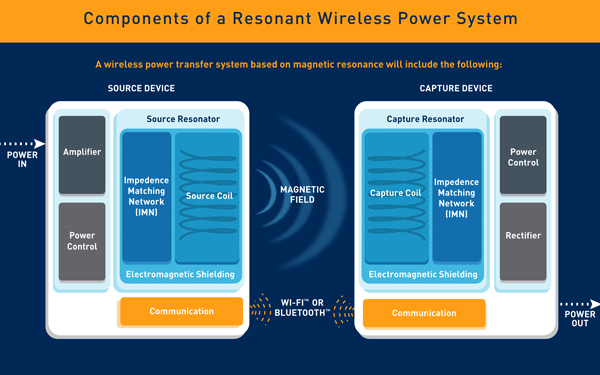 Eight years after it was founded with MIT-based technology, WiTricity appears ready for the bigtime with its wireless resonant energy transfer system, which is based on finely tuned oscillating magnetic fields between coils at a distance.
Eight years after it was founded with MIT-based technology, WiTricity appears ready for the bigtime with its wireless resonant energy transfer system, which is based on finely tuned oscillating magnetic fields between coils at a distance.
WiTricity (Watertown, MA) has an agreement with Intel to power computing devices over a distance without a cord. And Toyota has licensed the technology to use it in wireless power stations for electric cars.
In medtech, WiTricity has created a system for Thoratec that can transfer 10 watts of power into a human body to power an LVAD—a system that in the future should hopefully do away with the need for LVAD patients to have a wire running through their skin, says Colin McCarthy, sales engineer for medical and industrial at WiTricity.
“So even with high-powered devices, you could send it right through the skin,” McCarthy says. (See McCarty discuss wireless power technology at MEDevice San Diego, September 1–2.)
Expect WiTricity technology to show up in more medical devices, both inside and outside the body, McCarthy says. “We’re really targeting portable medical devices and all kinds of different hospital applications.”
McCarthy recently answered some questions from Qmed/MPMN about WiTricity and the future of its technology in medtech:
Qmed/MPMN: What is the major advantage of WiTricity’s technology?
McCarthy: “One of the nice things about resonant wireless power transfer systems is that … it can be very easy to charge something, to have someone sit in a chair or just not have to worry about charging a device, And because of that, it’s a little easier to say we’ll have people with implants charge more frequently. It’s not as much effort to do that. You can start to think of situations where you might decrease the weight and size of the battery in the device because its so easy to recharge it quickly.
“Because you have wireless power available to you, you can start to do more interesting things with implants. You can have them firing more often or using much more energy. Your kind of limited by how small these implants can be, and that limits your battery size. You have to figure out, ‘How do we make this a low power device?’ If you can easily charge it, it adds a lot more functionality to something like an implant.”
Qmed/MPMN: What makes your wireless resonant energy transfer system different from, say, traditional conductive power, in which you take two coils and line them up in close proximity?
McCarthy: “There are neurostimulators as well as some other devices on the market that use that technology, as well as other devices. The issue with that is that the efficiency tends to be quite low. Because of that low efficiency, you’re limited with how much power you transfer. If you transfer too much power at low efficiency, you’ll heat the device up. … Our technology allows you to improve that efficiency quite a bit.. … You need very high efficiency systems in these complex environments and complex applications.”
Qmed/MPMN: How small can WiTricity make a charging system?
McCarthy: “The coils can be quite small. With many of these devices, we’ll actually design a custom resonator. … We can make resonators on flexible PCBs, circuit boards. It doesn’t have to be a wound wire coil. It could be on a flex PCB. It could be thin and very light. You can bend it into the shape and size of the device you want it in. … You can get it down to less than a millimeter. We’ve demonstrated prototype hearing aid coils small enough that it could fit into a battery component of a hearing aid, where you’re limited to 8 mm diameters. We can fit it into the existing assembly.”
Read More – Source: Is This the Future of Wireless Power in Medtech? | Qmed
Posted in Electronic Components by Chris Newmarker on August 21, 2015